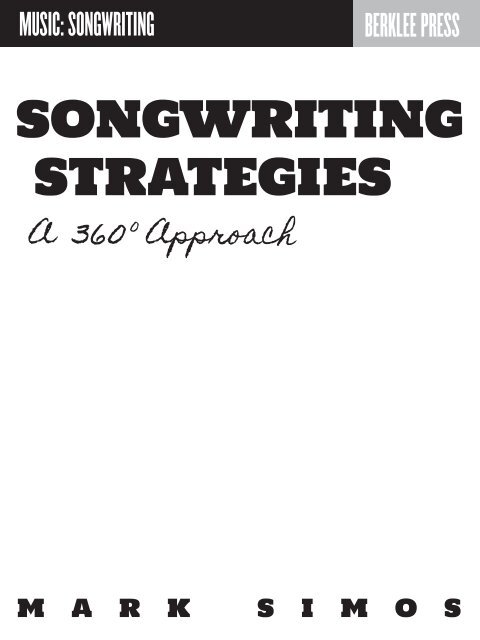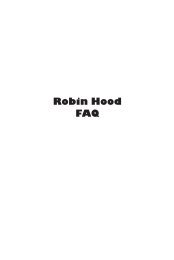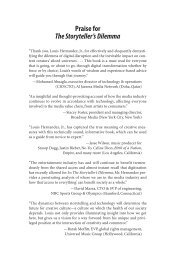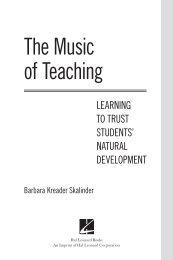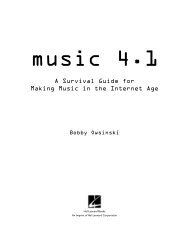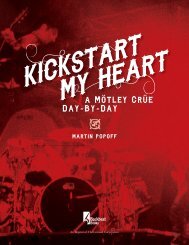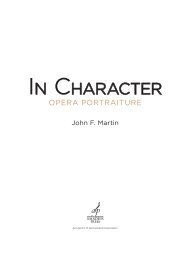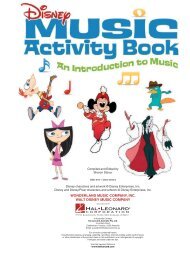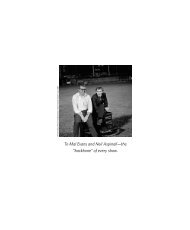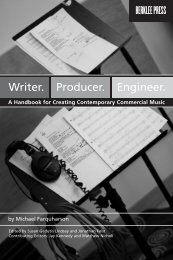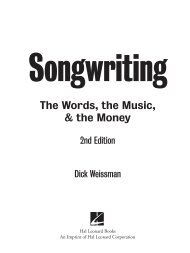Songwriting Strategies: A 360-Degree Approach
Create successful ePaper yourself
Turn your PDF publications into a flip-book with our unique Google optimized e-Paper software.
MUSIC: SONGWRITING<br />
BERKLEE PRESS<br />
SONGWRITING<br />
STRATEGIES<br />
A <strong>360</strong> º <strong>Approach</strong><br />
M A R K S I M O S
Berklee Press<br />
Editor in Chief: Jonathan Feist<br />
Vice President of Online Learning and Continuing Education: Debbie Cavalier<br />
Assistant Vice President of Operations for Berklee Media: Robert F. Green<br />
Assistant Vice President of Marketing and Recruitment for Berklee Media: Mike King<br />
Dean of Continuing Education: Carin Nuernberg<br />
Editorial Assistants: Matthew Dunkle, Reilly Garrett, Zoë Lustri, Sarah Walk<br />
Cover Design: Ranya Karifilly, Small Mammoth Design<br />
Cover Photo of Songwriter Conner Snow: Jonathan Feist<br />
ISBN 978-0-87639-151-8<br />
1140 Boylston Street<br />
Boston, MA 02215-3693 USA<br />
(617) 747-2146<br />
Visit Berklee Press Online at<br />
www.berkleepress.com<br />
Visit Hal Leonard Online at<br />
www.halleonard.com<br />
Berklee Press, a publishing activity of Berklee College of Music, is a not-for-profit educational publisher.<br />
Available proceeds from the sales of our products are contributed to the scholarship funds of the college.<br />
Copyright © 2014 Berklee Press<br />
All Rights Reserved<br />
No part of this publication may be reproduced in any form or by<br />
any means without the prior written permission of the Publisher.
CONTENTS<br />
ACKNOWLEDGMENTS vii<br />
INTRODUCTION ix<br />
CHAPTER 1. SONG SEEDS 1<br />
Catching Seeds 2<br />
Seeds and Personal Voice 3<br />
Seed vs. Filler 3<br />
Varieties of Song Seeds 5<br />
Concept Seeds 5<br />
Lyric Seeds 8<br />
Musical Seeds 12<br />
The Art of Seed Catching 15<br />
Exercise 1.1. A Week of Song Seed Catching 18<br />
Conclusion: Song Seeds and the Facets 20<br />
CHAPTER 2. THE SONGWRITER’S COMPASS 21<br />
The Four Facets 21<br />
Words and Music 21<br />
Sound and Sense 22<br />
The World 23<br />
Sound and Timbre 24<br />
Structure 25<br />
Traversing the Compass: <strong>Songwriting</strong> <strong>Strategies</strong> 26<br />
Setting 26<br />
Casting and Framing 27<br />
Structuring <strong>Strategies</strong> 29<br />
General Creative <strong>Strategies</strong> 30<br />
Summary of Compass Elements and Moves 32<br />
Example: Hurricane Revisited 33<br />
Framing “Hurricane” 33<br />
Setting “Hurricane” 35<br />
Exercise 2.1. Cast from a Concept Seed to Each Facet 39<br />
On to the Facets 40<br />
CHAPTER 3. RHYTHM 41<br />
The Challenge of Rhythm in <strong>Songwriting</strong> 41<br />
Working with Rhythm 42<br />
Dimensions of Rhythm in the Song 43<br />
Rhythmic Song Seeds 44<br />
Exercise 3.1. Compose a “Dry” Rhythmic Phrase 45<br />
Notating Rhythms: Woodblocks and Bagpipes 46<br />
Exercise 3.2. Write Interlocking Accompaniment<br />
and Vocal Rhythms 47<br />
The Temporal Framework 49<br />
The Flow of Musical Time 49<br />
Strict vs. Loose Time 49<br />
Pulse 50<br />
Time Signature and Tempo 51
Working with the Temporal Framework 51<br />
Exercise 3.3. Songwrite-Irama: Transform a rhythmic<br />
idea by altering tempo 52<br />
Accompaniment Rhythm 53<br />
Exercise 3.4. Cast from a Groove to a Lyric, Melody, Chords 54<br />
The Rhythmic Phrase 55<br />
Attributes of Lyric Rhythm 55<br />
Exercise 3.5. Regular to Irregular Lyric Rhythm 58<br />
Rhythmic Events 58<br />
Rhythmic Pace 60<br />
Rhythmic Patterns 62<br />
Working with the Rhythmic Phrase 63<br />
Exercise 3.6. Write a Rhythmic Song Section 63<br />
CHAPTER 4. LYRICS 65<br />
Sound Aspects of Lyrics 65<br />
Thought Phrase 66<br />
Word Boundaries 67<br />
Syllabic Stress Patterns 67<br />
Mapping Lyrics to Syllabic Rhythm 69<br />
Syllabic Rhythm Example 70<br />
Exercise 4.1. Develop Alternate Syllabic Rhythmic<br />
Settings for a Lyric Line 73<br />
Exercise 4.2. Pivot: Lyric Line } Syllabic Setting } New Line 74<br />
Syllabic Rhythm to Lyric Rhythm 74<br />
Anatomy of a Syllable 76<br />
Sound Color Aspects 76<br />
Additional Rhythmic Aspects 77<br />
Sense/Sound Lyric <strong>Strategies</strong> 78<br />
Lyric Sense to Sound: Paraphrasing 79<br />
Lyric Sound to Sense 80<br />
Lorem Ipsum: Dummies for Dummies 80<br />
Sense vs. Sound Approximations 80<br />
The Gibberish Scale: Seven Levels of Nonsense 82<br />
Exercise 4.3. Lyric-by-Sound <strong>Strategies</strong> 83<br />
Sonic Contours 84<br />
Exercise 4.4. Match a Lyric Line’s Sonic Contour 85<br />
Setting from Rhythm to Lyric 86<br />
Rhythm to Lyric by Sound 87<br />
Energy Contour of a Rhythmic Phrase 88<br />
Vowel and Consonant Contours 89<br />
Syllable Buds to Words to Lyrics 91<br />
A Few Small Repairs 92<br />
CHAPTER 5. MELODY 95<br />
Exercise 5.1. A Cappella, Rubato Melody 95<br />
Challenges in Melody Writing 96<br />
Thinking Melody 96<br />
Melodic Memory 97<br />
Exercise 5.2. Strengthening Melodic Memory 97<br />
Melodic Design 98<br />
Melodic Contour 99<br />
Melodic Shape: Scales, Arpeggios, and Figures 99<br />
Exercise 5.3. Write a Melodic “Ridgeline” 101<br />
The Power of Pentatonics 102<br />
Melodic Transformations 102
Shifting Figure and Field 103<br />
Melodic Range 104<br />
Melody/Rhythm Connections 105<br />
The Melody/Rhythm Continuum 105<br />
Rhythm to Melody 105<br />
Melody to Rhythm 106<br />
Melody/Lyric Connections 108<br />
Lyric Sounds and Melody 108<br />
Natural Intonation and Speech Melody 109<br />
Exercise 5.4. “The Well.” Transform a<br />
spoken line to vocal melody 109<br />
Lyric Rhythm and Melodic Contour 111<br />
Review of Syllabic and Lyric Rhythm 111<br />
Melismas and Chanting Tones 112<br />
Lyric Pace and Melodic Pace 113<br />
Redefining Melodic Rhythm 114<br />
Effects and Uses of Melodic Textures 117<br />
Process Considerations 117<br />
Melismas and Chanting Tones in Revision 118<br />
Melodic and Lyric Pace Relationships 119<br />
Exercise 5.5. Independence in Lyric and Melodic Pace 119<br />
Comfort Zones in Melodic/Lyric Pace 120<br />
Phrasing Templates 120<br />
Exercise 5.6. Phrasing Templates 121<br />
Exercise 5.7. Altering the Rhythm of a Chanting-Tone Melody 121<br />
CHAPTER 6. HARMONY 123<br />
Sound and Sense in Chords 123<br />
Sound Aspects of Harmony 124<br />
Sense Aspects of Harmony 124<br />
Process Considerations 125<br />
Chordal Song Seeds 127<br />
Chords as Sound, Shape, and Feel 127<br />
Chords at Your Instrument 128<br />
Exercise 6.1. Jackson Pollock 128<br />
Using Your Chord Seeds 131<br />
Chord Seeds Away from Your Instrument 132<br />
Chord Progressions 136<br />
Simple Chords 136<br />
Chord Roots as Scale <strong>Degree</strong>s 137<br />
Exercise 6.2. Six Chords in Search of a Composer 138<br />
Intervallic Motion in Chord Progressions 138<br />
Directional Effects of Chord Root Movement 139<br />
Rising and Falling Moves 141<br />
Exercise 6.3. Analyze a Progression by Root Motion 144<br />
Working with Root Tone Contours 145<br />
Exercise 6.4. Write a Progression Using<br />
Six Intervals of Root Motion 146<br />
Harmonic Rhythm 147<br />
Cyclic vs. Narrative Progressions 149<br />
Cyclic Progressions 149<br />
Narrative Progressions 150<br />
Motivic Progressions 151<br />
Exercise 6.5. Unwinding a Chord Cycle to a<br />
narrative Progression 153
CHAPTER 7. MELODY/HARMONY CONNECTIONS 155<br />
Independence of Melody and Harmony 156<br />
Melody/Harmony Counterpoint 157<br />
Species Counterpoint in Melody/Harmony 158<br />
Contrapuntal Motion in Melody/Harmony 159<br />
Melody/Harmony Contrapuntal Textures 159<br />
Pedal-Point Melodies 159<br />
Ostinato Melodies 160<br />
Parallel Textures 161<br />
Lazy Melodic Lines against Chords 163<br />
Exercise 7.1. Lazy Melody over Crazy Chords 164<br />
Chord-Driven Melodies 165<br />
Independent Tonal Melody 167<br />
Modal Melody/Harmony 169<br />
Expanding the Songbook 170<br />
Counterpoint in Modal Melody/Harmony 170<br />
Modal Palettes and Mosaics 172<br />
CHAPTER 8. STRUCTURE 175<br />
Structure in the Song 175<br />
Starting from Structure 176<br />
Structural Challenges 177<br />
Phrase Structure 177<br />
Exercise 8.1. Shift a Lyric Line against the Phrase 178<br />
Independence in Phrase Structure 178<br />
Exercise 8.2. Shift a Chord Sequence<br />
against a Structural Phrase 180<br />
Motivic Structure 181<br />
Motives vs. Song Seeds 181<br />
Unfolding: Motives into Structure 181<br />
Exercise 8.3. Answer the Question, Question the Answer! 183<br />
Fulfilling: Structure into Motives 183<br />
Exercise 8.4. Juggle Phrases in a Section 187<br />
Counterpoint in Motivic Structure 188<br />
Counterpoint within Facets 188<br />
Exercise 8.5. Contrapuntal <strong>Strategies</strong> in a Lyric Section 190<br />
Counterpoint Across Facets 191<br />
CHAPTER 9. USING THE COMPASS: FURTHER STEPS 193<br />
Revisiting the Compass 193<br />
The Compass as a Unity 193<br />
From Compass to Tetrahedron 194<br />
Facets: From Vertices to Edges 195<br />
Facets as Faces: Facet Triads 196<br />
From Counterpoint to Irony: Back to the World 198<br />
Sound and Sense: Facets, World, and Structure 200<br />
CONCLUSION: FROM A SONG TO THE WORLD 201<br />
ABOUT THE AUTHOR 203<br />
INDEX 204
ix<br />
INTRODUCTION<br />
This book presents a repertoire of songwriting strategies: practical strategies<br />
for writing songs, and learning strategies and exercises to help you advance as<br />
a songwriter. Using the tools and techniques described in this book, you’ll be<br />
able to draw on a broader range of sources of inspiration and starting points<br />
for songs. And you’ll be able to work with this material to write songs in more<br />
versatile and innovative ways.<br />
I call this approach <strong>360</strong>º songwriting. It’s grounded in a comprehensive<br />
model that encompasses and integrates four primary facets of songwriting:<br />
rhythm, lyrics, melody, and harmony. Each facet can connect directly to<br />
imagery, narrative, and emotion in the world, and each can also express<br />
structure and form in unique ways. This opens up a rich repertoire of strategies<br />
and skills for songwriters. We can start a song from seed material in any facet,<br />
and follow pathways to related material in any other facet, or cast content<br />
directly to material in any of the facets.<br />
Developing the skills to follow these different creative pathways will expand<br />
the productivity, scope, and versatility of your writing. It will help you get stuck<br />
songs “unstuck”—unfreezing “writer’s block” by accessing alternate processes<br />
or pathways. Above all, it will help you write better songs: songs with depth, craft,<br />
unity, and integrity—songs that take chances and stretch boundaries, for you as<br />
a writer and for the art of songwriting. As you expand your abilities to work from<br />
“the full <strong>360</strong>,” you’ll be writing songs from all directions, in all directions.<br />
This approach is simple in principle, but challenging in practice. We all<br />
have comfortable, familiar ways of writing songs. These serve us in good stead,<br />
until they don’t—when, at key points in our development as writers, they<br />
begin to hold us back. You can always improve your craft by reflecting on your<br />
habitual creative practices and trying new approaches. The <strong>360</strong>º approach<br />
offers a framework for exploring alternative strategies in a more systematic,<br />
comprehensive way. It can be taken up as a discipline for ongoing “creative<br />
disruption,” as needed, of creative processes that have become routine, safe,<br />
and predictable. One habit you do need to cultivate for <strong>360</strong>º songwriting,<br />
therefore, is the habit of breaking habits: seeking out and embracing challenges<br />
to your writing process, uncomfortable though they may be, unusable though<br />
initial results may seem—maybe even having fun along the way!
x<br />
Introduction<br />
In some respects, this work aims to be descriptive—providing a detailed<br />
process language for the “music of what happens” as songwriters write songs.<br />
This book does not set out, though, with the primary aim of describing what<br />
most songwriters are aware of doing in informal writing—even what I do in my<br />
personal approach to songwriting. Nor is it prescriptive, in the sense of advising<br />
you to write songs one particular way. It gives directions, not instructions—new<br />
options to explore. Toward that end, many new musical constructs, techniques,<br />
and tools are described herein, including many you’re not likely to find in a<br />
typical songwriter’s notebook—not yet at least! Use these as explanatory and<br />
practical aids to observing your own creative process at finer levels of detail—<br />
thereby discovering new ways to write songs, new kinds of songs to write.<br />
All examples in the book were composed by me, written specifically for<br />
the book to illustrate concepts and techniques, rather than excerpted from<br />
contemporary songs or my own working catalogue. Though not intended to<br />
illustrate any particular genre or style, the examples will necessarily reflect<br />
my musical background and vocabulary, and may or may not be to your taste.<br />
Work through the exercises, writing your own music, and I believe you’ll find<br />
the tools and techniques applicable in your preferred style and genre. Also put<br />
these ideas and techniques to the test by listening for examples (and counterexamples),<br />
both in widely known songs and in the music you know and love.<br />
The examples and exercises in this book make extensive use of both<br />
standard notation and some notational conventions I introduce. Supporting<br />
audio tracks for all examples and exercises, along with other supplemental<br />
information and resources, are available at www.<strong>360</strong>songwriting.com.<br />
This is a comprehensive set of strategies for songwriters’ creative work. The<br />
term “<strong>360</strong>º songwriting” only coincidentally suggests a connection to the now<br />
prevalent “<strong>360</strong> deals” between artist/writers, record labels, and publishers.<br />
Nevertheless, <strong>360</strong>º skills will benefit professional songwriters, in a music industry<br />
that rewards productivity and innovation, versatility, responsiveness, and an<br />
ability to collaborate with partners with widely varying processes and styles.<br />
While my aims are practical, you’ll find the tone of this book philosophical<br />
at times. Because great songs can move and touch ordinary listeners who have<br />
no special musical training, it’s easy to underestimate the complexity hidden<br />
beneath the surface of sometimes deceptively simple musical materials, and the<br />
profound artistic work songwriting demands of us as songwriters. For me, artistic<br />
freedom is mastering unconstrained movement within a creative domain. Though<br />
style constrains vocabulary, we artists explore the infinity of possibilities within<br />
any such vocabulary. For dancers, this means moving the body effortlessly and<br />
expressively through space with posture and gesture. The space songwriters<br />
dance through—the space we’ll explore together in this book—is bounded by<br />
the four songwriting facets, and the circle or “horizon” encompassing them.<br />
Learning to move in and through this space, working freely and independently<br />
with these elements, is the artistic path I call <strong>360</strong>º songwriting.
155<br />
CHAPTER 7<br />
Melody/Harmony<br />
Connections<br />
In this section, we outline a series of melody/harmony strategies, in order of<br />
increasing independence of melodic and harmonic elements. Rather than<br />
outline separate process directions of setting from melody to harmony or<br />
vice versa, we’ll describe a series of melody/harmony strategies in terms of<br />
textures that combine melodic and harmonic material in varying ways. Where<br />
appropriate, we may describe complementary textures that invert a given<br />
relationship of melody and harmony. While there is no intended aesthetic<br />
preference in the order in which these strategies are presented, there is an<br />
implied progression in terms of skill levels. Each texture has distinct emotional<br />
connotations and spotlighting effects, bringing various facets to the foreground<br />
or background.<br />
Used appropriately, each of these textural effects can serve the needs of the<br />
song. Some textures may be useful in earlier stages of writing, and then may be<br />
transformed or developed as the song progresses. But there’s always a risk of any<br />
texture devolving into a “lazy” strategy. We may fall back on certain textures<br />
more by habit than by design, and wind up with mismatches between the texture<br />
employed and our desired effect. If you’re thinking harmony as you write melody,<br />
you’ll tend to fall back on melodic habits requiring less thought, and vice versa.<br />
Imagine the songwriting facets as boundaries inscribing a creative space of<br />
possibilities. We want to be able to create material anywhere in this space. We’re<br />
not just looking for a life raft to take us from facet to facet; we want to swim in<br />
the whole ocean. That means being able to write different kinds of melodies—<br />
melodies locked tightly to harmony, melodies that float independently of<br />
harmony, and melodies that fall anywhere along this spectrum of possible<br />
melody/harmony textures. Rather than thinking in terms of a single creative<br />
operation—“setting from melody to harmony”—think of transforming a<br />
melody along the melody/harmony continuum. We want similar freedom in<br />
our chord progressions, whether we write these in response to melodies or as a<br />
springboard for melodies to come.
156 Chapter 7<br />
INDEPENDENCE OF MELODY AND HARMONY<br />
In theory, you can start from a song seed in any facet (rhythm, lyric, melody, or<br />
harmony) and set it to material in any facet. But as Einstein is reputed to have<br />
said, “In theory, theory and practice are the same. In practice, they are not.”<br />
A repertoire of different strategies helps if applying them gets you to different<br />
results. But if the seeds we start with are not actually separable but composites,<br />
the promised fruitfulness of this process flexibility is a bit of a fiction. Nowhere<br />
is this more of an issue than in relationships between melodies and chord<br />
progressions.<br />
Achieving true independence of melody and harmony is not so easy, even when<br />
apparently working with each element in isolation. To put this to the test, try to<br />
invent a song melody singing a cappella (without playing chords behind it). You’ll<br />
likely still hear an implied harmony—your melody generated with associations<br />
to imagined chords. Try to write multiple chordal settings for the melody. As<br />
you put different sets of chords to melody, the expected “already heard” chords<br />
will sound right; significantly different choices may sound “funny.”<br />
This close linkage of melodic and harmonic materials is in part a<br />
consequence of our spending our lives listening to harmonically saturated<br />
music. Conventional training in music theory can even work against you,<br />
making it more difficult to hear or create melodies without a harmonic context.<br />
Most Western-trained musicians and listeners are acculturated to harmony,<br />
by osmosis if not by formal training. Thus, they tend to hear a kind of silent<br />
chordal accompaniment when listening to even a solo melody.<br />
Working the other way, from chords to melody, presents different problems<br />
of independence. We can more easily write chord progressions without singing<br />
melodies over them. We may hear filler melodies as we write the chords, but<br />
it’s not too hard to hold these in abeyance and revise them later. The challenge<br />
here is, I believe, twofold: to find melodies that move sufficiently independently<br />
against chord progressions, and to find progressions not confined only to the<br />
logic of standard tonal harmony. Again, the influence of our harmonic training<br />
and expectations can be surprisingly stubborn. I often challenge student<br />
writers to create unusual chord progressions, and then to write melodies to<br />
those progressions. A writer may create a distinctive progression, one genuinely<br />
new for them. Yet, melodies they write to those progressions frequently sound<br />
as if they were written, not to the more innovative progression, but instead to<br />
an intuitively heard cliché progression that follows more expected harmonic<br />
paths and phrasing.<br />
Musicians with better-developed chops on a harmonic instrument like<br />
piano or guitar can generally devise more complex progressions, and even hear<br />
them away from their instrument. But that doesn’t translate directly to the skill<br />
of writing melodies over those chords that move in a more independent way. To<br />
develop this kind of bilateral independence between melody and harmony, we<br />
need to both learn and possibly unlearn some things.
Melody/Harmony Connections<br />
157<br />
If we start only from melodies where chords are already embedded or<br />
implied, or can only hear melodies to chord progressions that are “locked” to<br />
those progressions, then writing in “different directions” won’t yield<br />
fundamentally different kinds of songs. To expand the range, scope,<br />
innovativeness, and integrity of our songwriting, we want to find our way to<br />
new kinds of melodies, chord progressions, and combinations thereof. This is<br />
where the proverbial melodic rubber meets the chordal road.<br />
MELODY/HARMONY COUNTERPOINT<br />
We’ll organize our survey of the repertoire of melody/harmony textures by<br />
analogy to principles of counterpoint, adapted to our songwriting context. We’ll<br />
further broaden this analogy to counterpoint in our next chapter on structure,<br />
adapting the principles to contrasting (i.e., “contrapuntal”) structures and<br />
motivic patterns in different facets.<br />
Music theorists first articulated melodic principles in the context of<br />
counterpoint—interwoven multiple melodic lines. Some songwriting forms<br />
and genres, such as choral writing or a cappella group arrangements, are<br />
intimately tied to multi-voice textures. Our restricted scope of songwriting,<br />
here, involves a single vocal melodic line sung to chordal accompaniment.<br />
Still, we can adapt some concepts from traditional counterpoint for this more<br />
specific songwriting context.<br />
A primary goal of counterpoint is independent motion between voices<br />
(though similar and even parallel motion are constituent textures). Similarly,<br />
we can recognize a “contrapuntal” relationship between a song’s melody and<br />
harmony. Treating the harmonic accompaniment in a song as a “voice” depends<br />
on hearing the various implicit “melodic” lines in the chord progression, as<br />
discussed in the “Harmony” chapter. Any of these “line” aspects of chord<br />
progressions can be heard as countermelodies against the vocal melody,<br />
analogous to the multiple peer melodies of choral textures. The analogy is only<br />
approximate, however. We respond differently as listeners to vocal melody and<br />
to melodies in chord progressions, especially melodies formed by sequences of<br />
root tones.<br />
As in traditional counterpoint, we want an overall flexibility of independent<br />
motion between these voices, though that may involve passages of similar or<br />
parallel motion. We also want process flexibility—the ability to work (set) from<br />
either chords or vocal melody as the “given” (i.e., “cantus firmus”) material to<br />
which we respond.
158 Chapter 7<br />
<br />
Species Counterpoint in Melody/Harmony<br />
<br />
Traditional counterpoint 16 developed the notion of various species of<br />
contrapuntal motion, in part as a pedagogical sequencing into textures of<br />
increasing compositional challenge. In first-species counterpoint, notes of<br />
respective voices move 1-to-1, at the same melodic pace. Further species change<br />
this relationship, so voices move 1 note against 2, 1 against 3, etc. Lastly, “florid”<br />
counterpoint allows more freedom of pace across and among voices.<br />
There are characteristic pace relationships between the implied “melodies<br />
of the chords” and vocal melody in a song. Typically, movement of chords (and<br />
thus of their implied melodic lines) is slower than the changing pitches of vocal<br />
melody. Thus the basic melody/harmony connection in songwriting generally<br />
feels like counterpoint of species 2 or 3, in contrast to the shifting rhythmic and<br />
pace relationships between lyric rhythm and melodic contour (discussed in the<br />
“Melody” chapter).<br />
The proportions and pace are not strict. Given overall differences in pace<br />
for both melodic and harmonic motion, there’s great freedom in ways these<br />
two threads can move. A chord may be held while the melody moves, or chords<br />
can move when the melody is still—e.g., behind a long sustained note (or<br />
repeated pitches) of the vocal melody, or around phrases. Figure 7.1 shows a<br />
simple example section exploiting this variability in the pace of melodic and<br />
harmonic movement.<br />
G<br />
   <br />
<br />
<br />
You use your words to hurt me and you real - ly twist the knife. I wish you’d find an - oth - er fool and<br />
E–<br />
<br />
<br />
<br />
let me get on<br />
<br />
with my life.<br />
C<br />
<br />
F<br />
<br />
Bb<br />
D<br />
<br />
<br />
Be<br />
<br />
my ex-<br />
wife!<br />
G<br />
C E–<br />
<br />
A– D<br />
<br />
FIG. 7.1. Varying Melodic/Lyric and Harmonic Pace<br />
This sense for the relative pace of motion in vocal melody and chords<br />
respectively has practical implications. First, we need to pay close attention to<br />
moments where vocal melody sounds against changes in the chord progression.<br />
Chord changes are rhythmic spotlight positions, heightening effects such as<br />
chord tone vs. non-chord tone relations between melody and the “chord of the<br />
moment.” Second, it’s at the slower pace of the “melody of the chords” that<br />
rhythmic patterns of the chord progression itself— the harmonic rhythm—are<br />
articulated. These patterns are hard to hear, not just because they move slower<br />
than rhythmic patterns in vocal melody; they’re also only heard superimposed<br />
on (or heard beneath) the melody, unless you work with the harmony in isolation.<br />
Chords-first writing helps you to hear this harmonic rhythm more clearly,<br />
16. Traditional counterpoint studies were canonized by Joseph Fuchs’ classic Gradus Ad Parnassum (1725).
Melody/Harmony Connections<br />
159<br />
and eventually to compose and execute more elusive rhythmic patterns. This<br />
enables you to experiment more boldly with effects such as rhythmic shifts in<br />
the chord progression: varying durations on chords, using anticipations and<br />
moves on weak metric beats, etc.<br />
Contrapuntal Motion in Melody/Harmony<br />
Another key concept in counterpoint involves different kinds of motion between<br />
voices:<br />
• In similar motion, voices move in the same direction (higher or lower<br />
in pitch). Parallel motion is similar motion by the same interval (in<br />
diatonic scale degrees; that is, one voice might move a minor third<br />
while one moves a major third, etc.).<br />
• In oblique motion, one voice stays still as the other moves.<br />
• In contrary motion, voices move in different directions.<br />
Contrary motion is given a certain esteem in contrapuntal thinking: in part<br />
because it requires the most skill and preparation to conceive and perform,<br />
and in part because of its effect on the ear, creating a simultaneous pull of<br />
focus to both voices. However, practical contrapuntal textures mix all these<br />
types of motion in any extended passage, balancing independence of separate<br />
voices with harmonic agreement in their juxtaposition.<br />
MELODY/HARMONY CONTRAPUNTAL TEXTURES<br />
These different types of contrapuntal motion have counterparts in the varied<br />
textural strategies for melody/harmony connections in songwriting we’ll<br />
explore in the following sections.<br />
Pedal-Point Melodies<br />
The term “pedal” or “pedal point” is usually applied to a note in a lower bass line<br />
of the harmony, repeatedly sounded under a melodic passage. The harmony is<br />
usually active during such passages. In a songwriting context, however, simply<br />
holding one chord, or even a drone or partial chord, for a passage or a section<br />
can be viewed as an extension of this kind of texture.<br />
We can also consider a complementary texture, where the vocal melody<br />
maintains a held tone against changing chords—in effect, a “pedal point melody.”<br />
This texture echoes the contrapuntal idea of oblique motion, where one voice<br />
is still as another moves. The quiescent melodic line spotlights or moves to the<br />
foreground the root or bass line motion of the chords, which in turn recolor the<br />
harmonic interpretations of the held melody note. Using a chanting tone melodic<br />
contour is also a good strategy for focusing attention on lyric content. Rhythmic<br />
effects are often used in pedal-point melody for additional interest.
160 Chapter 7<br />
Great songwriters and composers in all styles and genres have used this<br />
texture to compelling effect: from Antonio Carlos Jobim’s classic “One Note<br />
Samba” to the opening phrases of Donovan’s “Catch the Wind.” It’s a sound<br />
now iconic in the music of contemporary acoustic singer-songwriters. A simple<br />
example is shown below. Chord roots are indicated in the bottom staff. The<br />
“pedal-point” melody creates pleasing effects, as the held C note shifts between<br />
chord tone and non-chord tone roles against the chord of the moment: 5 of the<br />
F, 6 of the Eb , 3 of the A b , 2 of the B b . A bit more interest comes through varying<br />
the rhythmic pattern across the four bars.<br />
   <br />
F Eb<br />
<br />
Ab<br />
<br />
<br />
Bb<br />
<br />
<br />
<br />
<br />
FIG. 7.2. Pedal-Point Melody. Relatively dependent on chord progression.<br />
A pedal-point melody can hold notes on different scale degrees relative to<br />
underlying chords, forming varying chord tone and non-chord relations. Here’s<br />
another example over the same chords, with the held note forming successively<br />
a 2, 3, major 7, and 6 (resolving to a 5) against the underlying chords:<br />
<br />
<br />
F<br />
<br />
<br />
  <br />
<br />
Eb<br />
<br />
<br />
Ab<br />
Bb<br />
<br />
<br />
FIG. 7.3. Non-Chord Tone Melodic Pedal Point<br />
The biggest risk in pedal-point textures (of either variety) is when they’re<br />
used as an improvisational “cheat,” rather than a compositional choice, to<br />
achieve a specific emotional or narrative effect. But used with intent, they offer<br />
a powerful technique for spotlighting, and especially for sectional contrast.<br />
Ostinato Melodies<br />
An extension of the pedal-point melody strategy sets up a repeating melodic<br />
figure or ostinato against a sequence of changing chords. As with a single-note<br />
pedal, the repeating melodic figure is recolored by the shifting interpretation<br />
against the changing chords. This recoloring is more effective when the melodic<br />
figure isn’t too closely tied to a single chordal area (as with a scalar passage or<br />
arpeggiated chord).
Melody/Harmony Connections<br />
161<br />
<br />
F<br />
<br />
Often, repeated rhythms help reinforce the ostinato pattern, as in figure<br />
7.4. Here the E note in the repeated ostinato figure takes on shifting non-chord<br />
tone roles over each chord, until it resolves as the third of the C chord.<br />
G–<br />
<br />
  <br />
<br />
<br />
<br />
D –<br />
C<br />
<br />
<br />
FIG. 7.4. Melodic Ostinato over Changing Chords<br />
<br />
<br />
This strategy extends a sense of oblique motion to the border between<br />
melody per se and phrase structure—not the melodic note, but the melodic<br />
figure or motive remains fixed as the chords move. The example shows a typical<br />
template: the melodic motive is varied (by truncation) at the end of the phrase,<br />
setting an aaab melodic structure against the through-written chordal line.<br />
A melody that shifts in range and/or contour against a cyclic chord progression<br />
within a section inverts this texture. As repetition or cycles are brought to the<br />
foreground in either melody or harmony, a secondary “pace” is created at the<br />
motivic level. This pace interacts with other rhythmic aspects of the song.<br />
Parallel Textures<br />
The contrapuntal device of similar or even parallel motion is reflected when vocal<br />
melody follows a melodic aspect of the chord progression. The paralleling can<br />
track various melodic threads in the harmony. Also, as with pedal-point melody,<br />
the vocal melody can “track” the chord melody at varying intervals, such as at<br />
the third or fifth, or with non-chord tones. The most audible, and potentially<br />
problematic, case is when vocal melody sounds or doubles chord roots. Figure<br />
7.5 shows two largely parallel-motion melodic settings for a chord progression:<br />
one doubling chord roots, the other hovering around the 3 rd of the chords.<br />
   <br />
F<br />
Eb<br />
<br />
<br />
Ab<br />
<br />
Bb<br />
<br />
<br />
<br />
F<br />
Eb<br />
Ab<br />
<br />
<br />
<br />
<br />
Bb<br />
<br />
<br />
FIG. 7.5. Melody Moving in Parallel to Chord Root Tones<br />
As the second example above shows, this type of similar or parallel motion<br />
might be disguised by activity in the melody, yet still contribute a weakness<br />
to the overall texture. The vocal melody can be very active in relation to chord<br />
movement, yet still be moving in a harmonically parallel way. This is a case<br />
where vocal prowess in particular needs to be applied with caution. Vocalistwriters<br />
will easily add flourishes around a melody that still essentially parallels<br />
the harmony. This may yield a compelling vocal performance, but a less<br />
interesting melody and song.


